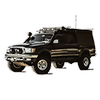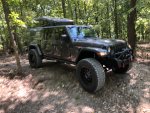v2.0
You are using an out of date browser. It may not display this or other websites correctly.
You should upgrade or use an alternative browser.
You should upgrade or use an alternative browser.
Gladiator Pop-Up Pass Through Camper Build
- Thread starter Mules
- Start date
Mules
Well-known member
I still have plenty of life left in my OEM starter battery, but when It's time, I'll be replacing it with an Antigravity Lithium Starter battery 80AH. I've been keeping an eye on other people using them in Jeeps, and so far so good. Basically an 80AH Lithium Battery can discharge down to 10% while our stock OEM AGM batteries should only be discharged 50%. The bottom line is installing a 60 or 80AH Lithium battery is comparable to installing a dual battery in my Gladiator while saving a ton of weight. I'm still curious about cold weather usage though.
Here's a discussion about Antigravity Batteries on a Wrangler Forum. Another member also installed one with the optional 240 amp alternator (on the Gladiator's tow package). Be careful sizing Lithium batteries as some can't handle the 240 amp alternator.

Here's a discussion about Antigravity Batteries on a Wrangler Forum. Another member also installed one with the optional 240 amp alternator (on the Gladiator's tow package). Be careful sizing Lithium batteries as some can't handle the 240 amp alternator.

Last edited:
Mules
Well-known member
Along with my bright idea of installing an 80AH Lithium Starter battery, I'll need to install a decent sized inverter. I want to install the inverter in the Gladiator and not in the bed, so I can still use it without the camper on. What do you think about these four locations for the Inverter. I think a 1500 watt is small enough to conceal and big enough to run anything I need.
1) Under the Driver's seat. Looks like I can fit a Slim Line Inverter here, but probably not a pure sign wave one which is bigger than the Slim Line. The HVAC duct is flexible enough to pull over the inverter.

2) I like the location behind the driver side back seat. I would have to mount the inverter vertically though. Here's a shot of a dual compressor installation there, which is also pretty cool. This location is nicely concealed.

3) There's plenty of room under the back seats, but I prefer to keep this area for easy access storage of recovery gear and other frequently used items.

4) Under the hood would be my ideal location which would keep the heavy supply lines to the battery short, but most inverter manufacturers discourage this location due to high temps and moisture.

What do you guys think?
1) Under the Driver's seat. Looks like I can fit a Slim Line Inverter here, but probably not a pure sign wave one which is bigger than the Slim Line. The HVAC duct is flexible enough to pull over the inverter.
2) I like the location behind the driver side back seat. I would have to mount the inverter vertically though. Here's a shot of a dual compressor installation there, which is also pretty cool. This location is nicely concealed.
3) There's plenty of room under the back seats, but I prefer to keep this area for easy access storage of recovery gear and other frequently used items.
4) Under the hood would be my ideal location which would keep the heavy supply lines to the battery short, but most inverter manufacturers discourage this location due to high temps and moisture.
What do you guys think?
chris the ogre
Beer Drinker
Mine has alligator clamps attached so I only connect when I need it. Plus, I can use it on any truck/car at camp.
Mules
Well-known member
Here's a Tacoma with a Lithium Starter battery used for overlanding. He seems pretty happy with it.

 www.takethetruck.com
www.takethetruck.com

The Do Everything Overlanding Battery That May Make Dual Battery Systems Obsolete | Take The Truck
If you’ve been looking for the best overlanding battery for your travel and camping adventures, this new dual-purpose lithium overland battery just might be the perfect solution!
Last edited:
86scotty
Cynic
I can't tell you where the perfect place is for your inverter but I would not put it under the hood. Under driver's seat seems like a pretty solid idea. Not much else fits there. In my JLU mine (and OBA compressor and Noco lithium charger) are in the little hatch in the rear but you don't have that.
Personally I like air compressors outside. They are too noisy, still when outside, but I don't like them in the rig. Is there nowhere under the truck bed to mount your compressor?
Also, you mentioned cold camping/electric heater, etc. Do you not have room to stuff a CDH (Chinese diesel heater) somewhere? Super cheap and very effective.
Personally I like air compressors outside. They are too noisy, still when outside, but I don't like them in the rig. Is there nowhere under the truck bed to mount your compressor?
Also, you mentioned cold camping/electric heater, etc. Do you not have room to stuff a CDH (Chinese diesel heater) somewhere? Super cheap and very effective.
Mules
Well-known member
Sounds like good advice. I still have a lot of room to put stuff under the camper seats in the back. I don't air down, so I can't justify installing a permanent compressor, but I bring along a 12v portable one when needed, mainly for my ATV or Tractor at camp.I can't tell you where the perfect place is for your inverter but I would not put it under the hood. Under driver's seat seems like a pretty solid idea. Not much else fits there. In my JLU mine (and OBA compressor and Noco lithium charger) are in the little hatch in the rear but you don't have that.
Personally I like air compressors outside. They are too noisy, still when outside, but I don't like them in the rig. Is there nowhere under the truck bed to mount your compressor?
Also, you mentioned cold camping/electric heater, etc. Do you not have room to stuff a CDH (Chinese diesel heater) somewhere? Super cheap and very effective.
I have plenty of room for a diesel heater in the camper. That's probably the way to go if I plan on cold weather camping. I still haven't figured out where to cut a hole for the exhaust though. So far, I haven't drilled a single hole in my truck.
Last edited:
86scotty
Cynic
Sounds like good advice. I still have a lot of room to put stuff under the camper seats in the back. I don't air down, so I can't justify installing a permanent compressor, but I bring along a 12v portable one when needed, mainly for my ATV or Tractor at camp.
I have plenty of room for a diesel heater in the camper. That's probably the way to go if I plan on cold weather camping. I still haven't figured out where to cut a hole for the exhaust though. So far, I haven't drilled a single hole in my truck.
Check out the suitcase type ones. You just need a hose to the truck and a power source. I've seen some neat home builds using a Pelican case. That way, just carry when you need it. Personally, I'd mount one fixed but I understand if you don't want to cut holes. However, your rig is pretty irreversibly modified as a camper, lol.
Mules
Well-known member
Great video on Clayton track bar which will make room for a 37" spare tire. ! Now I'm wondering if I can get a 38" spare under my Gladiator with a new track bar?!
Just some advice for anyone like me that runs a smaller spare tire. I run 38" tires but have a factory spare. This is not a great solution, but will get me to a shop. Don't run smaller spare on the back axle or in 4 wheel drive. You can run them on the front without 4 wheel or diff lock engaged. Remember the circumfrance is different, which will cause problems when the axle is engaged. If you have a flat rotate the tires so you have the smaller spare on the front.
Just some advice for anyone like me that runs a smaller spare tire. I run 38" tires but have a factory spare. This is not a great solution, but will get me to a shop. Don't run smaller spare on the back axle or in 4 wheel drive. You can run them on the front without 4 wheel or diff lock engaged. Remember the circumfrance is different, which will cause problems when the axle is engaged. If you have a flat rotate the tires so you have the smaller spare on the front.
Mules
Well-known member
Looks like a 37" spare might fit depending on it's actual size. The second video has a great explanation, but the bottom line is there is 36.5" between the track bar and the back hitch. There's a lot of factors such as if you moved back your axle with an aftermarket lift, if the spare is inflated or not, if the spare is smaller due to being used, what width rim you are running, and the original diameter of the spare.
Mules
Well-known member
I’m still recovering from my operation, but I can’t sit around any more. I took a little trip to my camp ground to see how it faired this winter. I couldn’t get all the way with the truck because of a washout. Good thing I had my UTV. Looks like I’ll have some trail fixing this summer.







Mules
Well-known member
Mules
Well-known member
Here's an interesting product. Some small and relatively cheap power stations are now capable of running much larger appliances. Pecron E600 for $299 can power up to 1200 watt appliances such as microwaves and hot plates due to it's large inverter. Basically this is cheaper than installing a large inverter. Only issue is it's battery only has 600wh capacity. If you are only going to use the power supply for cooking and LED lighting, this is a pretty cheap option. It can recharge pretty quickly by solar or AC also. I think I would need to drive/run my Gladiator for 1.5 hours to recharge it using my built in inverter or 3 hours with a 200Watt Solar collector.
I think this is the cheapest way to power an electric hotplate, coffee maker, and/or microwave. Your wife can even bring a hair dryer if you're willing to give up your morning coffee! Probably only good for one day before needing recharge.

I think this is the cheapest way to power an electric hotplate, coffee maker, and/or microwave. Your wife can even bring a hair dryer if you're willing to give up your morning coffee! Probably only good for one day before needing recharge.
Last edited:
Similar threads
- Replies
- 0
- Views
- 494
- Replies
- 12
- Views
- 1K
- Replies
- 6
- Views
- 799


